Relating Silk Emergence at Pollination to Kernel Set at Harvest
Summary
- Maximum kernel set and grain yield occur when pollen shed coincides with rapid silk growth.
- Silks attached near the base of the ear emerge first, and silk emergence progresses toward the tip of the ear. Kernel set also progresses from the base to the tip of the ear.
- Under the environmental conditions of this study, silks remained receptive to pollination for about five to six days. Maximum silk growth was about 1.6 inches per day.
- For this study, the number of kernels per ear correlated highly (r 2 = 0.95) with grain yield per ear.
- Grain yield was constant if the total number of kernels/ear was constant. The corn ear may compensate for poor kernel set at the base by producing more kernels at the tip.
Introduction
Successful corn yield production requires adequate pollen when silks are receptive during pollination. Pollen shed, or anthesis, and silk emergence is controlled by a combination of genetic and environmental factors. The genetic background of the corn plant provides a general baseline for the necessary number of growing degree units until anthesis.
Once pollen grains have matured inside corn anthers, these anthers begin to dry and dehisce. As anthers dehisce, they allow pollen grains to fall into the open air and possibly land on receptive corn silks. The process of pollen growth and maturation inside corn anthers with the subsequent drying and splitting of corn anthers to allow pollen release is similar to the process of growth and maturity in soybean, with the drying and splitting of the pods to release the soybean seeds.
Environmental conditions, such as relative humidity and temperature, are contributing factors for anther dehiscence. During summer nights, temperatures are relatively cooler and relative humidities higher, so anthers maintain a more hydrated state. As the morning progresses, temperatures tend to increase and relative humidities decrease, thus drying corn anthers. Anthers containing mature pollen typically shed pollen around mid-morning. A tassel will normally shed pollen for about five days.
Temperature and available moisture also play extremely critical roles for silk emergence, elongation, and exsertion past the tip of the husk. Under ideal temperature and moisture conditions for corn growth, silk exsertion is very rapid and consistent throughout similar areas of the field. However, if corn plants are subjected to dry conditions or drought stress, silk emergence may be delayed and rates of silk growth reduced. Changes in silk growth may affect the number of kernels set on the harvested ear.
Field Study Conducted
DuPont conducted a field study relating silk growth at pollination to kernel set at harvest. Ear shoots were covered before any silks were exposed. On the day before silks were to be exposed to pollen, researchers selected 20 ear shoots, clipped the silks back to the tip of the husk, and covered them with ear shoot bags for 1 day. The next day, the shoot bags were removed from 10 of the shoots, exposing the silks to open pollination for 1 day. These ear shoots were then covered with bags to eliminate additional exposure to pollen.
The remaining 10 ears were handharvested. New silk growth was measured from the tip of the husk for silks attached to developing ovules in kernel positions 5, 15, 25, and 35 from the base of the ear. Cob length and width were also measured. Silk lengths were measured by covering the exserted silks with red “carpenter’s chalk.” The ears were carefully extracted from the husks with silks still attached, and the lengths of red silks at the various kernel positions were measured. This procedure was repeated daily during the entire pollination window. Environmental and soil moisture conditions were nearly ideal for corn growth and pollination. After the crop matured, the selected ears were harvested, kernels per ear were counted, and grain yield per ear was measured.
Relating Daily Silk Growth to Grain Yield
The following series of pictures illustrates daily silk growth and kernel set of matched ears during pollination. Data in the graphs are averages of 10 replications. Pictures for a particular day represent average responses.
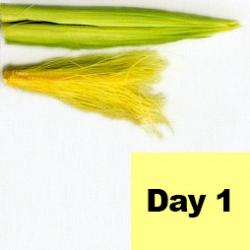
Pictures for the 12 days during pollination follow the same format: a picture of the developing ear and a picture of a corresponding ear at harvest.
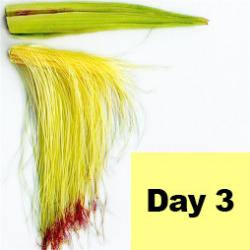
Initially, silks grow most rapidly at the base of the ear. Kernel set matches silk emergence. 50% silk emergence in field occurred on Day 4 of the study.
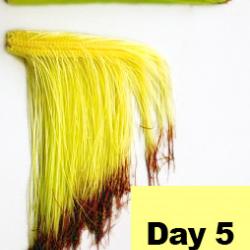
Under these environmental conditions, maximum silk growth was ~1.6 in/day. Silk growth is slower under drier conditions.
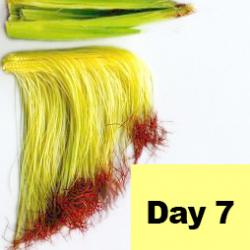
All silks are visible and growing. This is the second of two days in which the entire ear was pollinated.
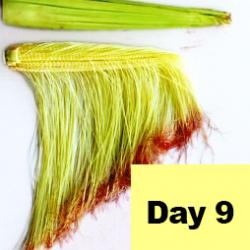
Under these environmental conditions, silks remained viable for five to six days. The first silks to emerge are the first silks to lose pollen receptivity.
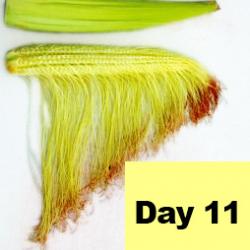
Silks along the entire ear remain receptive to pollen for five to six days. The sequence in loss of silk receptivity follows the sequence of silk emergence.
Cumulative Growth During Pollination
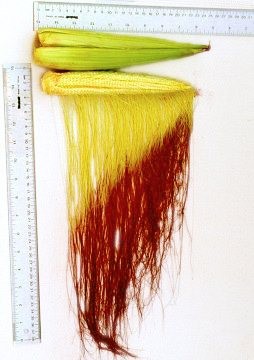
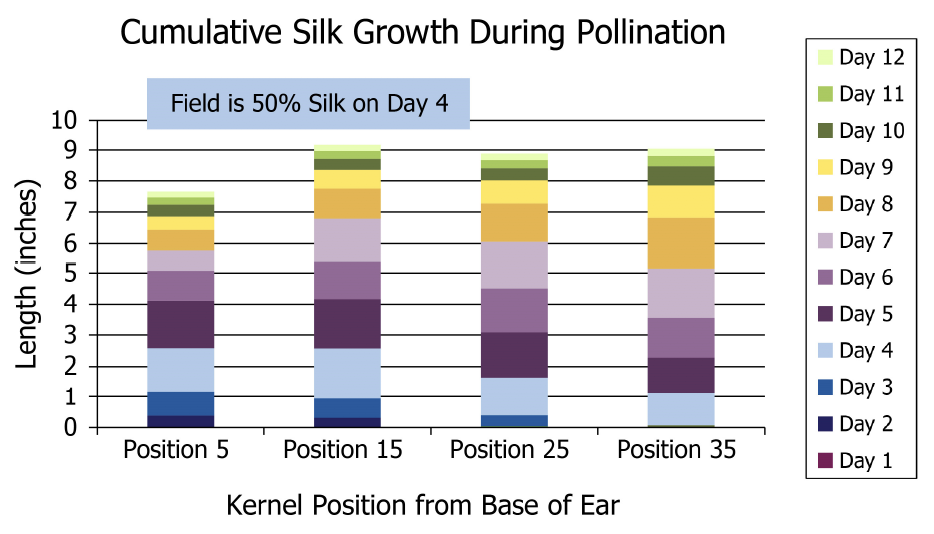
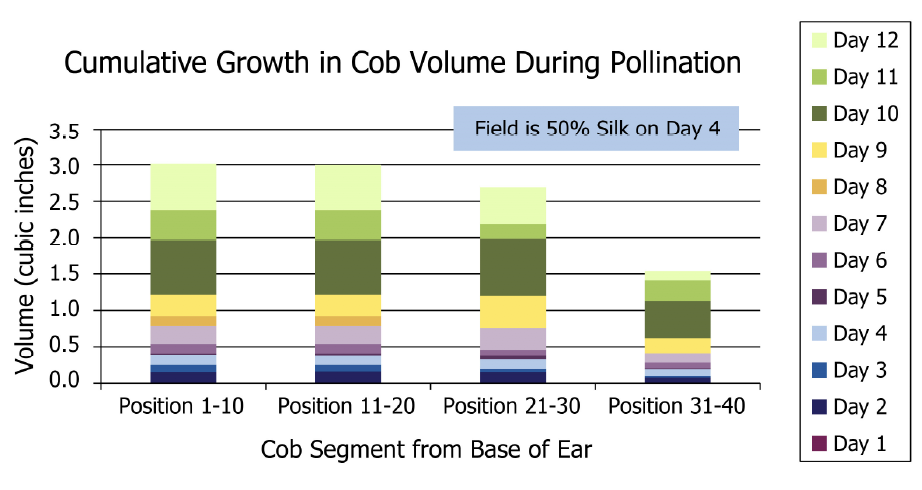
- Silks continue to grow until either the developing ovule to which the silk is attached is fertilized or until the silk completes its life cycle.
- Total silk growth approaches approximately nine inches past the tip of the husk.
- Based on daily silk and cob measurements during pollination, the developing ear focuses the majority of its resources on silk growth in order to better catch viable pollen.
- After a few days, silk growth slows and the developing ear focuses its resources on cob growth in order to provide space and support for developing kernels.
- The probability of successful pollination decreases as silks enter the latter phases of their life cycles.
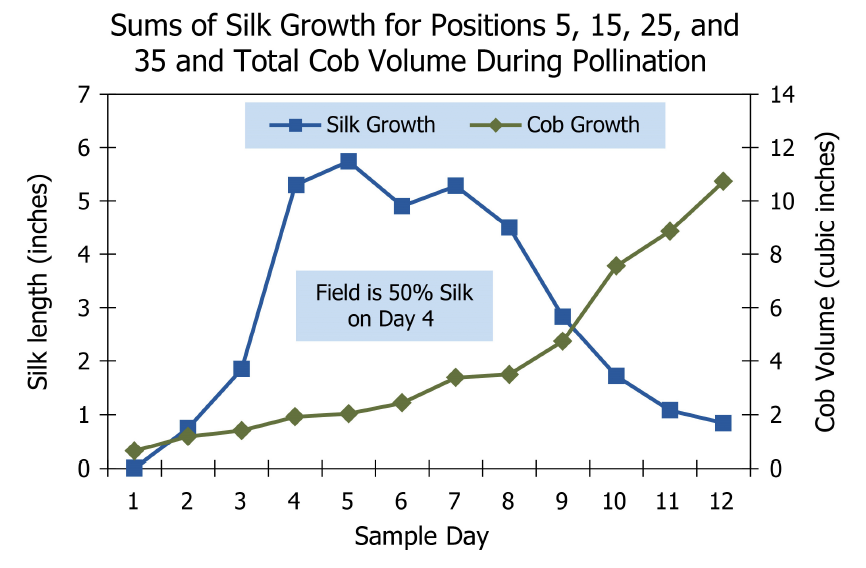
Estimating Grain Yield When Incomplete Pollination Occurs
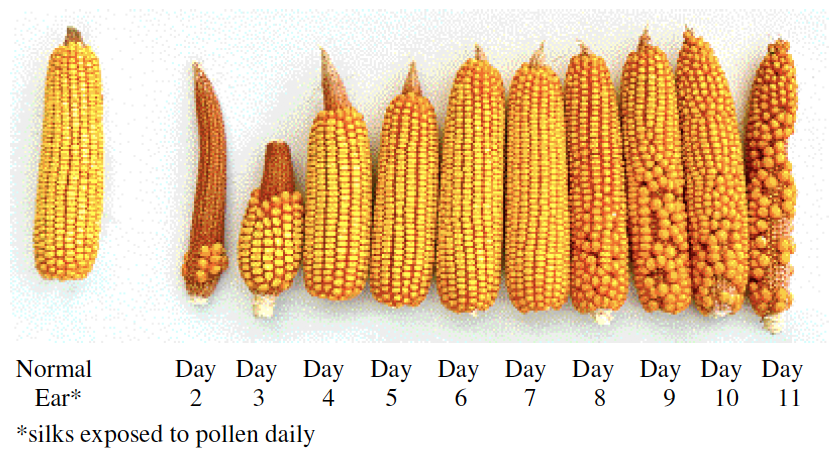
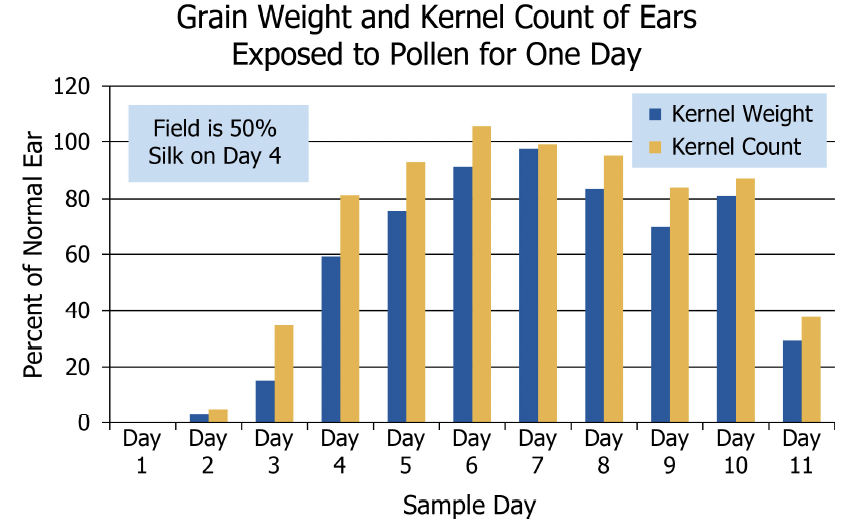
Grain yield per ear is a function of the total number of kernels produced multiplied by the weights of these individual kernels. In these studies, grain yield per ear correlated very highly with the number of kernels produced per ear. A small loss in kernel number does not substantially reduce grain yield because the kernels surrounding the area of the missing kernel will often compensate by becoming a bit larger. However, as the loss in kernel count becomes excessive, the remaining kernels on the ear cannot grow sufficiently to compensate for the loss in kernel numbers. Ears produced on “Day 5” and “Day 8” have different appearances but similar grain yields and kernel counts. Corn ears will often compensate for poor kernel fill at the base of the ear by increasing the kernel fill at the tip. The corn plant has a specific amount of resources that it will devote to grain fill. During the grain-filling interval, the corn plant will adapt to the best of its ability with the resources available to produce maximum yield of the viable kernels attached to the corn ear.
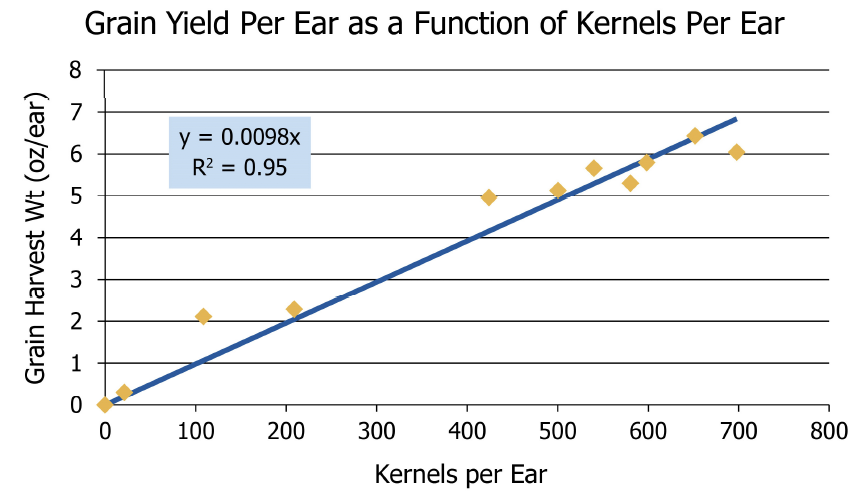
Grain yield per acre is also a function of the total number of kernels per acre times the individual weights of these kernels. Approximately 85% of the variability in grain yield is related to the number of kernels produced per acre while the remaining 15% of the variability in grain yield is related to the weights of these kernels (Otegui et al., 1995). Corn growing on an acre of soil under specific environmental conditions is capable of devoting a certain amount of resources to grain yield. Two cornfields with similar grain yields will most likely have similar amounts of kernels produced per acre. The cornfield with the higher population will likely have more but smaller, harvested ears than a cornfield planted at a lower population. The challenge before agronomists and farmers is to manage an ever-changing supply of resources so that the corn properly partitions these resources between vegetative and grain yield demands.
